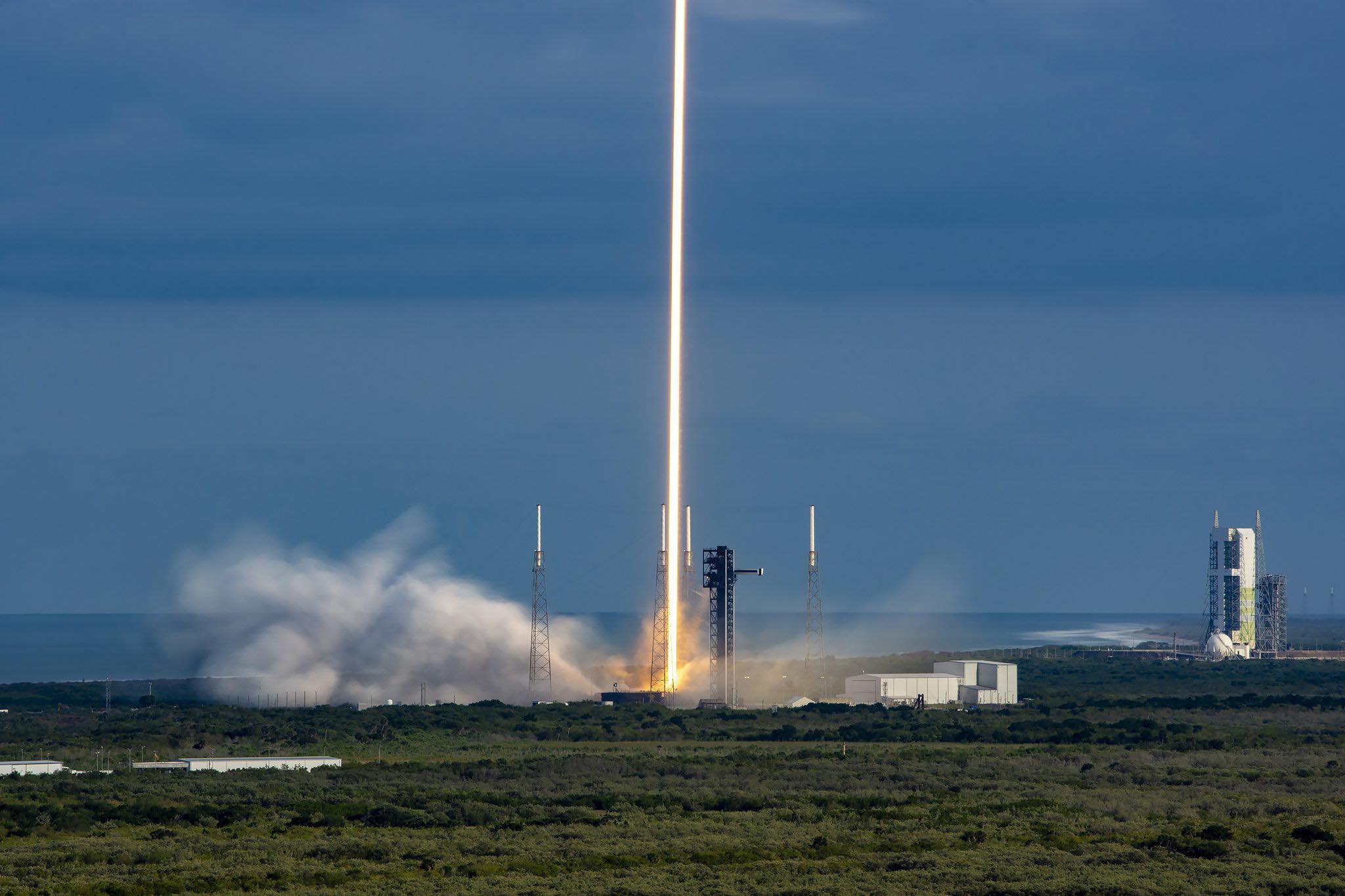 B1078 rises atop a column of fire from the Cape’s historic Space Launch Complex (SLC)-40 at 6:17 p.m. EDT Tuesday. Photo Credit: SpaceX
B1078 rises atop a column of fire from the Cape’s historic Space Launch Complex (SLC)-40 at 6:17 p.m. EDT Tuesday. Photo Credit: SpaceXSpaceX has successfully landed its 300th booster, following Tuesday evening’s post-sunset flight of a many-times-used Falcon 9 out of storied Space Launch Complex (SLC)-40 at Florida’s Cape Canaveral Space Force Station. The B1078 core—which first sprang onto SpaceX’s scene last March to loft Dragon Endeavour and her Crew-6 quartet of NASA astronauts Steve Bowen and Warren “Woody” Hoburg, Russian cosmonaut Andrei Fedyayev and Sultan Al-Neyadi of the United Arab Emirates (UAE) for their six-month Expedition 68/69 increment aboard the International Space Station (ISS)—took flight for the ninth time at 6:17 p.m. EDT and returned eight minutes later to alight on the expansive deck of the Autonomous Spaceport Drone Ship (ASDS), “Just Read the Instructions”, situated offshore in the Atlantic Ocean.
It marked the 300th successful recovery on land or at sea of Falcon 9 boosters or Falcon Heavy side-boosters, an impressive tally which has now seen hardware alight 233 times on drone ships in the Atlantic or Pacific Oceans since April 2016 and 67 times on solid ground at Cape Canaveral or Vandenberg Space Force Base, Calif., since December 2015. During that span of time, there have been eight failed ASDS landing attempts—most recently in February 2021—and a single “land” landing failure, in which the returning booster was instead ditched at sea in December 2018.
Most recently, the historic B1058 core, which earned renown as the one-time ride to space of “Bob and Doug” and was until last December the most-flown member of SpaceX’s fleet, toppled over on the drone ship’s deck and was partially lost at sea. Notable successes included the synchronized return of Falcon Heavy side-boosters to Landing Zones (LZ)-1 and 2 at the Cape for the first time in February 2018.
Last night’s launch also marked the tenth Falcon 9 to take flight so far in April, achieving a cadence of a flight every 2.3 days and positioning SpaceX well on track for its oft-stated goal of up to 144 missions by the end of the year. April has seen ten boosters with 102 flights between them—including the first 20-times-used booster—lift over 180 Starlink low-orbiting internet communications satellites, the 11-payload Bandwagon-1 “rideshare” mission to a mid-inclination orbit and the Space Force’s first Weather System Follow-on Microwave (WSF-M) next-generation environmental monitoring satellite.
In readiness for launch, the East Coast-based drone ship, “Just Read the Instructions”, departed Port Canaveral on Saturday for her recovery position in the Atlantic Ocean. And late Monday, SpaceX announced that it was targeting an expansive “launch window” ranging from 6:17 p.m. EDT through 9:25 p.m. EDT Tuesday, with backup availability on Wednesday and attempts opening at 5:50 p.m. EDT.
Weather conditions for both attempts were predicted to be 95-percent-favorable, with only a slight risk of violating the Cumulus Cloud Rule on Tuesday. A high-pressure center offshore to Florida’s northeast was expected to “allow a low-topped, mixed stratocumulus-cumulus deck to stream onshore,” the 45th Weather Squadron at Patrick Space Force Base noted, although this was not expected to pose a launch weather concern.
B1078 took flight on time at 6:17 p.m. EDT, kicking off the ninth voyage of a career which began with Crew-6 in March of last year and went on to lift six batches of Starlinks, a pair of O3b mPOWER broadband satellites and the Space Force’s highly secretive USSF-124 payload of six discrete spacecraft—two Hypersonic and Ballistic Tracking Space Sensor (HBTSS) satellites for the Missile Defense Agency (MDA) and the final four Tranche 0 Transport and Tracking Layer (TTL) satellites for the Space Development Agency (SDA)—into orbit. Across only 13 months of active operational service, B1078 has transported more than 130 payloads aloft.
Powering uphill under the thrust of her nine Merlin 1D+ engines, the core burned out at 2.5 minutes into ascent and returned to a picture-perfect JRTI touchdown at eight minutes into the flight. Meanwhile, the single Merlin 1D+ Vacuum engine of the second stage ignited for a six-minute “burn” to deliver the 23 Starlinks the rest of the way to orbit, with deployment timed at just shy of 65 minutes into the mission.
As a network, Starlink enables high-speed and low-latency internet provision to over 70 sovereign nations and international markets in North and South America, Europe, Asia, Oceania and Africa. Earlier this week, the Hawthorne, Calif.-headquartered launch services provider announced that Starlink connectivity is now available in Albania, bringing to 74 the total number of sovereign nations or regions to receive coverage.
The downsized V2 Mini satellites, first flown in February of last year, boast three to four times greater “usable” bandwidth than earlier Starlink iterations. “V2 Minis include key technologies—such as more powerful phased-array antennas and the use of E-Band for backhaul—which will allow Starlink to provide 4x more capacity per satellite than earlier iterations,” SpaceX explained. “Among other enhancements, V2 Minis are equipped with new argon Hall thrusters for on-orbit maneuvering.”
Florida-based intercity operator Brightline adopted Starlink on its trains in 2023, the first passenger rail service in the world to do so. Additionally, El Salvador’s Ministry of Education has begun integrating Starlink capability into its schools to help close the digital divide between urban and remote rural communities and 50 Rwandan schools are now connected via Starlink’s high-speed internet service.
And in January, SpaceX lofted its first six “Direct-to-Cell” Starlinks, which permit mobile network providers to offer “seamless global access to texting, calling and browsing”, whether “on land, lakes or coastal waters”, without the need to change hardware or firmware. Within six days of that first launch, SpaceX engineers sent and received their first text messages via Direct-to-Cell and as of this month Starlink reportedly has about 2.7 million registered subscribers or customers worldwide.


 Crypto Daily™
Crypto Daily™ BlockchainReporter
BlockchainReporter Optimisus
Optimisus DogeHome
DogeHome Crypto News Land
Crypto News Land Optimisus
Optimisus Crypto News Land
Crypto News Land Crypto News Land
Crypto News Land






















